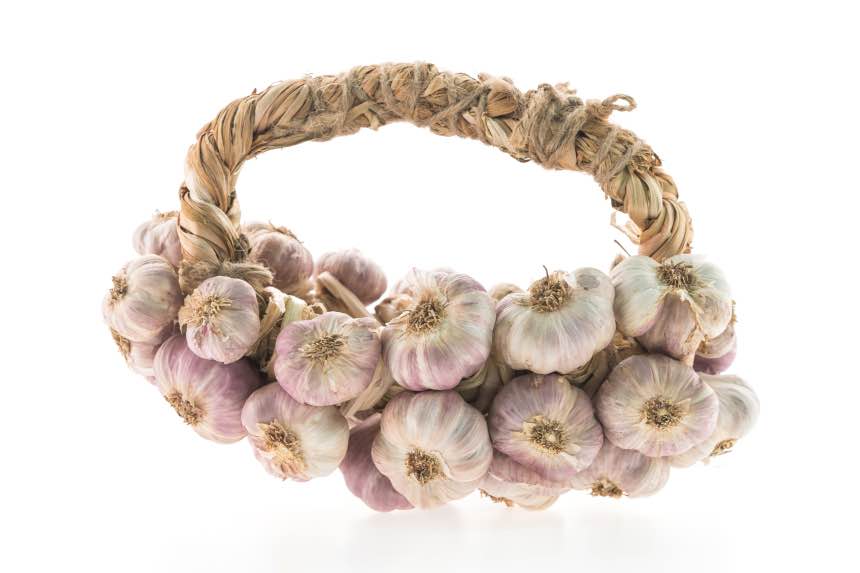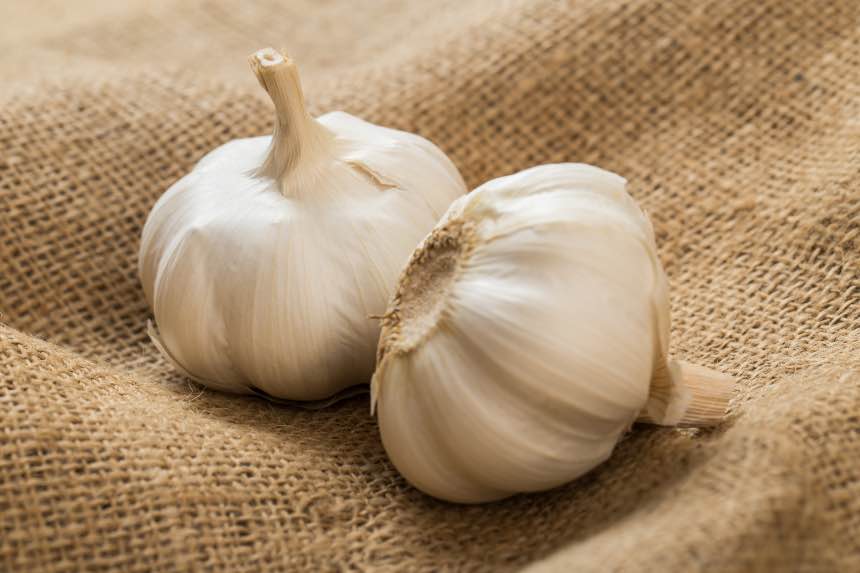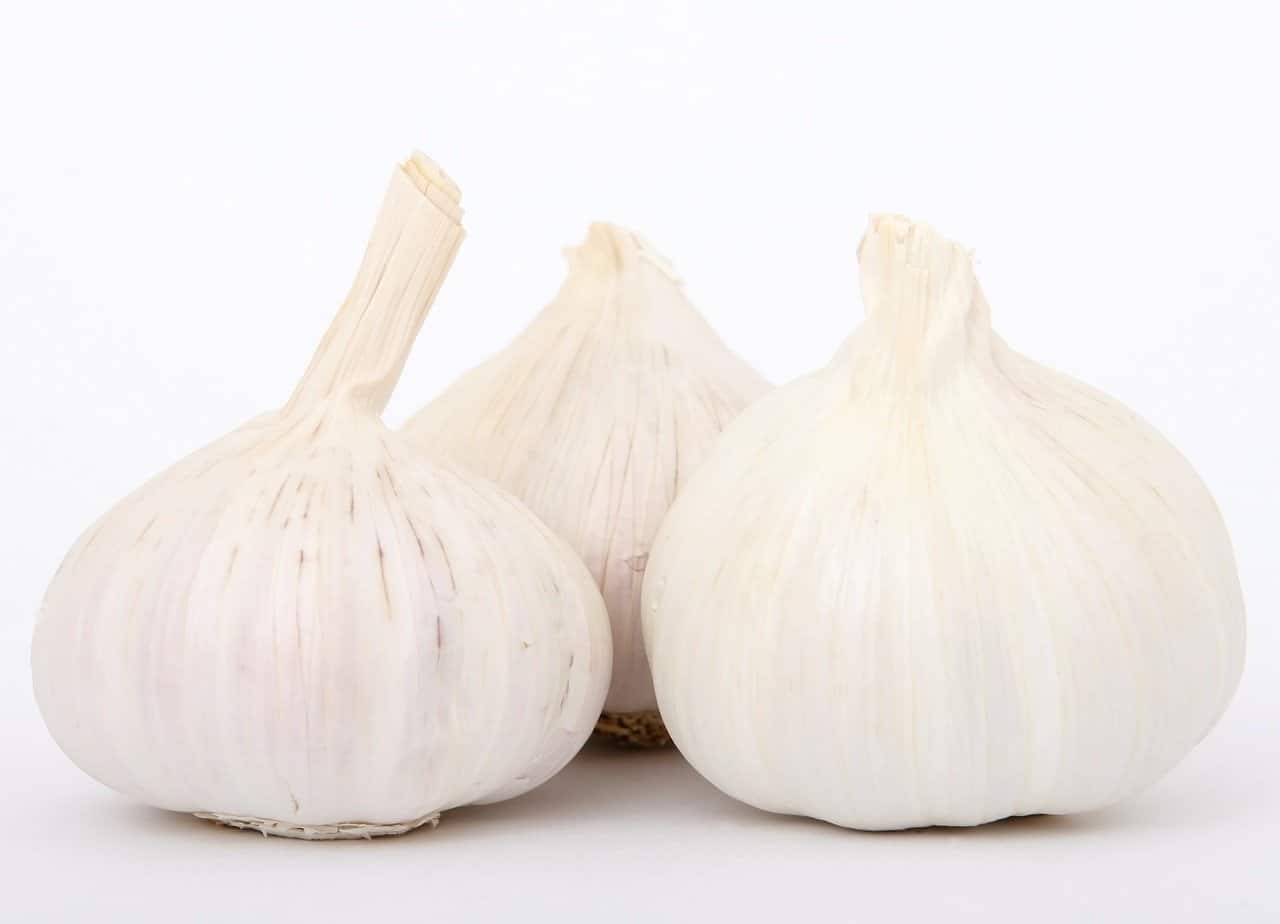Garlic is one of the most versatile herbs and one nearly every pantry has. It is not only a necessity in enriching the flavors of many dishes but also provides multiple health benefits making it extremely popular around the world. This combo of nutrition and flavor makes it a great choice for gardeners, and growing it indoors gives you a longer, constant supply of this herb. With that in mind, let’s jump right in and learn how to grow garlic indoors.
Growing Garlic Indoors Overview
- Garlic is easy to grow both outdoors and indoors in containers
- Start garlic with cloves. You can sometimes use ones bought at a grocery store, but those sold specifically for gardening are preferred.
- Outdoors, plant your garlic in the fall. You can do so indoors as well but have more freedom on when you plant.
- Give your garlic plant at least 8 hours of sunlight, but a little more won’t hurt.
- Water when the soil is dry to the touch, about once every 3-5 days in summer. Fertilize once per month while growing.
- Harvest as the leaves begin to die and the bottom of the stalk starts to brown.
- Stored properly, garlic remains fresh for up to 2 months.
Garlic plant warnings
While it is a relatively easy plant to grow, the garlic plant needs an ample amount of sunlight and aerated, nutrient-rich soil to flourish. You’ll want to make sure that you have a location with lots of light or be prepared to supplement with grow lights.
On a positive note, garlic is fairly frost tolerant and can survive a light frost. This makes them an excellent first choice for the spring if you’re planning to grow outside. In fact, you can actually plant garlic seeds in the fall and they will survive the winter and sprout in spring. This is the standard way of growing garlic. Indoors this isn’t really relevant but is still a neat fact.
Garlic Varieties
Before planting it’s important to figure out which type of variety of garlic you want to grow. In general, there are two kinds of garlic Hardneck and Softneck. There is also an Elephant variety, but this is technically a leek and also much larger which makes it less than ideal for indoor growing.

Softneck Garlic
Softneck garlic is generally easier to grow, although it is a little less cold-tolerant than hardneck. It also has a braidable stem. Softneck tends to be a little smaller, but this is ideal for those growing indoors with limited space.

Hardneck Garlic
Hardneck garlic grows a thick stalk through the center of the bulb and tends to have more color variations. This variety is particularly cold hardy, so is great if you want an outdoor garlic plant and live in a colder climate. It also tends to have a slightly stronger flavor.
It’s important to keep in mind that these are both broad categories. There are more sub-categories of garlic inside each of these.
When selecting a variety to grow, it really doesn’t matter all that much for indoor growing. If you’re growing outdoors, then try to find a local variety that grows well in your climate. A store-bought garlic clove will work well indoors, but may not be suited for your climate in an outdoor garden.
Planting, Soil, and Container
To start growing garlic indoors all you need are some cloves. You can simply take store-bought cloves and place them into a container and, given proper care, you’ll be able to grow a fresh garlic plant. This is an interesting and fun way to start your plant that is different from most other types. We’ll talk more about the specifics of this process in the next section.
Note that while you can try cloves bought from a grocery store, it’s best to buy ones specifically sold for gardening. Grocery-bought garlic sometimes is treated to prevent sprouting, which will prevent it from growing when planted.

Tip
If growing outdoors, find cloves that are commonly grown in your climate for the best results. Indoors, nearly any type will do.
In either case, you want to choose a container that is at least 8-10” deep. Garlic roots go deep but don’t spread out much, so choose a container that is deeper than wide. Each clove should be planted about 6” apart from each other. If you’re using a small, windowsill pot you may only want to plant a single clove in it. As always, ensure your chosen container has proper drainage.
Fill your chosen pot with high-quality potting soil. Most store-bought soil will be fine, but you can always go with vegetable-specific soils as well and they may perform better.
How to Plant Garlic Cloves
Starting with cloves is a bit unique and not something many gardeners have tried before. Luckily, it’s pretty simple and only takes a couple of easy steps. Start by gathering your chosen container and filling it with soil.
Next, plant the cloves point side up and cover with no more than 1/2 inch of soil. You can plant more cloves to start to ensure a healthy one survives and then prune them back once you see growth. 3-4 to start is a good number to shoot for. Once they start growing, thin them to give each one about 6” of space. I highly recommend trying this route as it is very easy and lots of fun to start from a non-traditional method like seeds.
If you have a whole bulb that’s okay too, you can simply break out the cloves and plant them as above. One word of caution though, some store-bought bulbs may have been treated with chemicals to prevent sprouting on the shelf. You want to avoid these, and should instead look for bulbs specifically sold for growing to prevent wasted time.
Water and Feeding
Garlic will be a heavy feeder during the summer and requires a bit of care to keep growing. You’ll want to check the soil and water if it begins to dry out. Most people will water once every 3-5 days, but this can be more if it’s unusually dry or hot.
For feeding, you’ll want to use a nitrogen-rich fertilizer roughly once per month. If you start to see your plants’ leaves yellowing (and you’re keeping up watering) you can opt to fertilize a bit more. This is a common issue and one that is easily corrected if dealt with quickly. It’s a good habit to check your plant daily for both moisture and feeding needs.
Once the summer fades, you’ll typically be able to cut down on both watering and feeding. For those planting in the fall, you generally won’t need to feed your plants until spring when they really start growing. In most cases, it’s actually bad to fertilize at this time as it can promote premature growth.
Garlic’s Sunlight Needs
As noted above, garlic is a fairly light-hungry plant and will not do well in low-light conditions. Look to get it at least 8 hours of bright light per day. Less than this and your plant will likely not grow well and may fail to produce anything edible.
Outside of watering, not enough light is the next big killer for garlic plants. Supplementing with grow lights may be required, especially in the cooler and darker months or if you’re growing indoors. There’s no secret here, always make sure your plant is getting as much light as possible.
Harvesting Garlic
Harvesting garlic is a bit more involved than other plants, but not difficult once you get the hang of it. Wait until the bottom of the stems begin to brown and a few leaves have died off. You should still have some green left, but noticed that the plant has slowly begun to die off.
In the week or so leading up to the harvest stop watering the plant. This helps the plant cure in the ground and also makes it easier to pull out.
Once you’re ready, gently pull the whole bulb out of the ground. You want to break up the soil a bit before doing so as pulling too hard can actually separate the stalk from the bulb. Once the bulb is out gently wipe off any excess dirt by hand. Don’t use water or get the bulbs wet at this point.
Curing and Storing Garlic
Once you harvest, you’ll want to let the garlic cure for about 10 days before using. You can either bundle several stalks together and hang them bulb-side down or lay them flat in a cool dark place. Afterward, the garlic is ready to use to spice up any recipe.

Tip
Make sure there is proper airflow between your garlic bulbs while curing. This prevents mold from developing on your harvested garlic.
After its cured, garlic will last up to 2 months. Store it in a cool, dark, and dry place as this will help it store for longer. It’s also a good idea to keep the whole head together. Once you break out the cloves you have limited time before the garlic will go bad.
Better Health - Garlic Plant Benefits
As previously mentioned, garlic can help you in many ways. There’s evidence that it reduces the risk of a heart attack, brightens your skin, boosts immunity and so much more.
Furthermore, it also acts as an excellent repellent for animals. Many animals are turned off by the smell and taste of garlic, and will usually leave your plant alone. It has also been shown to repel mosquitoes. This makes it excellent for growing on a balcony or other areas that might be exposed to wildlife. A bit of garlic can actually help keep your area bug free. It’s also a great companion plant when grown in containers due to this.
How to Grow Garlic Indoors
Garlic is a fantastic choice for indoor gardeners, and hopefully, you’ve learned the key steps on how to grow garlic indoors. While it is light-hungry and feeding heavy, it is still a quite hardy plant and can deal with a bit of forgetfulness. Give it a bright spot and check it every few days and you’ll be enjoying delicious and healthy garlic in no time.
How to Grow Garlic Indoors
How Long Does It Take For a Garlic Plant to Grow?
After a week, you will start to see stems and leaves sprout from your plant. If you want, you can snip them and use them for cooking as well. However, it will take about two to three weeks for the leaves to grow properly. A fully mature plant however can take as long as 9 months to grow, so it’s certainly not a short-term project.
What Do I Do If My Garlic Leaves Are Yellowing?
The first step is to make sure you’re watering it enough, this is often the cause of yellowing leaves. Next, if you are watering it the correct amount, give your plant a little extra, nitrogen-rich fertilizer. Don’t go overboard though as you could burn out the plant. Opt for organic compost if available.
Can You Grow Garlic From Cloves?
Yes, you can simply place the cloves into the ground and care for them as normal. Do take care though, some store-bought varieties may have been treated to prevent sprouting.







